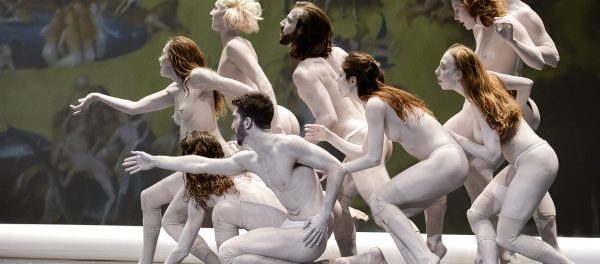Marie Chouinard’s Garden of Earthly Delights: The Ecstasy of Creation
 Photo © Sylvie-Ann Paré. Interprètes Carol Prieur, Morgane Le Tiec, Valeria Galluccio, Leon Kupferschmid, Sacha Ouellette-Deguire, Paige Culley, Megan Walbaum, Lucy M. May, Scott McCabe.
Photo © Sylvie-Ann Paré. Interprètes Carol Prieur, Morgane Le Tiec, Valeria Galluccio, Leon Kupferschmid, Sacha Ouellette-Deguire, Paige Culley, Megan Walbaum, Lucy M. May, Scott McCabe.
When was the last time you took a good look at Hieronymous Bosch’s early 16th-century painting “The Garden of Earthly Delights?” I mean, really looked at it, at all the bizarre details: the guy with a flower coming out of his butt; the group of people assembled around a giant strawberry, nibbling away; the couple lying side by side, sharing an intimate moment, which would all be fine except the man’s head is actually a blueberry; the man carrying a giant clam shell in which two people are lying; the person head down in the river, spread legs sticking up; the two figures encased in a transparent sphere? And that’s just the central panel. What about the hellscape on the right panel: the ears brandishing a dagger; the phallic bagpipes and mega-recorders; the scary creature on a sort of throne swallowing a human whole; the ghostly tree/eggshell man; the choir singing music off of someone’s butt? When did music become so evil and scary? And why was Bosch so obsessed with butts? The left side of the triptych is a little easier to handle: God incarnate, Adam, Eve, lots of animals—your basic Garden of Eden scene, although with some odd structures thrown in for good measure.
Now imagine taking a magic pill that allows you to enter these strange worlds Bosch put on canvas over five centuries ago, like Alice falling through the looking glass. That pill has a name, and it’s Marie Chouinard, who brings these tableaux to life on stage at Théâtre Maisonneuve. And it’s weird, whacky, wonderful, terrifying, glorious, and ecstatic, in that order.
Chouinard’s piece takes place in three acts, one for each panel. She starts with the central panel. Art historians haggle about the significance of this panel—does it represent humans acting without regard to consequences, indulging in hedonistic pleasure-seeking that will eventually send them to hell? Or does it merely show the innocence of humans before the fall? Chouinard seems to believe the latter. While the panel is projected onto the backdrop, details are projected onto two circles at each side of the stage; each of these is brought to life and elaborated on by the dancers. So, for example, the man with flowers coming out of his butt becomes a multitude of dancers joyously leaning over and sticking their hands between their legs, their fingers becoming blossoms between their buttcheeks. The couple with the blueberry head becomes a series of couples, each one moving as a single entity across the stage on their tummies. The giant strawberry scene is replicated with a huge inflated transparent globe, which later becomes an egg into which the whole troupe enters and does a happy dance. The dancers wear only flesh-coloured thongs, and are covered in talc, as if they really are the somewhat androgynous, pale forms in the painting. Their movements in this section are animal-like and strangely erotic, evoking at times an almost zombie-like naivete, innocence, and discovery.
The second act is a different story. The backdrop is black; there is no sun. The depraved, perverse, insane nightmare of the Hell panel is brought to life, soundtrack and all. Live screams and moans and shrieks accompany the futility and absurdity of the dancers’ movements. One woman with a huge blonde wig tries to climb a ladder; hanging by her hands from one of the top rungs, she continually slides back down, her belly rubbed raw from the metal stairs. Another propels herself forward on a wheeled stool, a crazed multi-legged creature run amok. One wears a rubber boot on his head, others have scraps of material wrapped around random body parts. One is stuck in a bucket. The stage is strewn with debris, including a skeleton and a couple of 15-foot long wind instruments, at one time worn by a dancer on her arms. This section is so uncomfortable to watch and to hear, that I wanted it to end a little sooner than it did. But then again that’s probably the point.
The third act, by comparison, is a blessing. Literally. God (a woman) stands on stage in front of Bosch’s God (a man) on the backdrop. Adam (a woman) sits down next to her, as in the painting; Eve (a man) kneels to the right. Then multiple Adams and Eves appear, of both sexes. And God transfers her robes to a man. The screens to either side of the stage now show human eyes: green on the left, blue on the right, watching over the scene, blinking, pupils dilating and shrinking. God him/herself, presumably. The dancing in this section is ecstatic. The mood is peaceful and mature. I wondered if perhaps Chouinard herself had found God. Then I realized that the God we’re all there to worship is indeed the God of creation; we are all taking pleasure in the ecstasy of creation, the ecstasy of bringing art to life.
The Garden of Earthly Delights is not an emotional piece; rather it is a piece of playfulness and free association. Chouinard’s work is not a creation of profound emotion, but, rather, one of imaginative overload.
The Garden of Earthly Delights plays September 28, 29, 30 at Théâtre Maisonneuve at Place des Arts at 8:00pm. Tickets. Tickets $44-$75 at ticketmaster.com.





